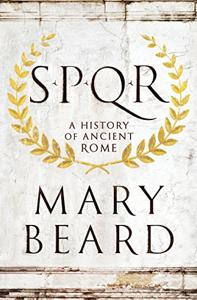
Want to learn the ideas in SPQR better than ever? Read the world’s #1 book summary of SPQR by Mary Beard here.
Read a brief 1-Page Summary or watch video summaries curated by our expert team. Note: this book guide is not affiliated with or endorsed by the publisher or author, and we always encourage you to purchase and read the full book.
Video Summaries of SPQR
We’ve scoured the Internet for the very best videos on SPQR, from high-quality videos summaries to interviews or commentary by Mary Beard.
1-Page Summary of SPQR
Overview
SPQR is a book on Ancient Rome written by Mary Beard. It covers the history of Rome from 753 BC to 212 CE, when Caracalla made all free adult males born within the empire Roman citizens.
The book opens with the Catiline conspiracy, a plot against Rome by one of its citizens. From there, it offers analysis of choice topics in Roman history. These include citizenship and military service as well as religion and slavery. The impact of historical figures such as Cicero, Julius Caesar, and Emperor Augustus on the growth of Rome is also addressed.
The key to Rome’s success was its openness to new ideas. These ideas helped Rome, a small village on the swampy banks of the Tiber River, rise to become an influential empire. Engaging with Roman civilization has relevance to our own understanding of modern times; some events from Roman history are similar to debates in modern time (for example citizenship and security versus liberty).
The title of the book refers to a Latin phrase that means “The Senate and People of Rome.” This was used on Roman documents, coins, and buildings throughout history.
Key Takeaways
The Roman Empire had a strong influence on the political geography and ideas that are still prevalent today. The Romans closely controlled their subjects’ religious beliefs, as well as how they expressed those beliefs.
The role of women in society has changed over time. In the Roman Empire, women had more rights than many other places around the world at that time. The military success of Rome was due to its large population and logistical advantages, which allowed it to field a huge army. Slavery was common in ancient times, but slavery wasn’t driven by ideology or religion; instead, slaves were used for labor and support purposes.
The ancient Romans had an idea of citizenship. It was a forerunner to modern ideas about citizens’ rights and responsibilities. While we have written sources about the ancient Romans, our knowledge is limited by a lack of archaeological evidence.
Key Takeaway 1: The Roman Empire greatly influenced the political geography and political ideas that drive our modern world
The Roman Empire has had a huge impact on the world today. From Algeria to Azerbaijan, you can find its ruins and artifacts. However, that’s not all it left behind; cities such as London were founded in Roman times and still bear their stamp of influence today. The layout of the streets in Cologne also reflects its heritage as a former Roman garrison.
The Romance languages are derived from Latin, which is a Roman language. They include Spanish and Romanian among others. In addition to being the basis for many words in other languages, Latin has also influenced science and politics as well. The Romans were the first to establish a political system that was based on ideas of constitutionalism.
Key Takeaway 2: For the Roman Empire, religion and the state were closely intertwined. The Roman state sought to closely control the religious beliefs of its subjects.
Religion was different in the Roman Empire than it is today. Religion helped to hold the empire together and played a big role in social life. Most people weren’t really concerned with whether or not their religious beliefs were correct, but rather they followed certain practices.
The Roman emperor was the head of religious worship in ancient Rome. The role was largely nominal for some emperors, such as Augustus. This form of government is known to us today as caesaropapism or erastianism. The Roman experience with state-controlled religion established a precedent and a model for subsequent Roman and Byzantine approaches to Christianity. This also happened in Tsarist Russia. Sometimes this meant that Romans took a syncretistic approach to religion, whereby other deities became franchises of existing Roman gods; sometimes it meant forcing people to worship in approved places or pay lip service to certain gods.





